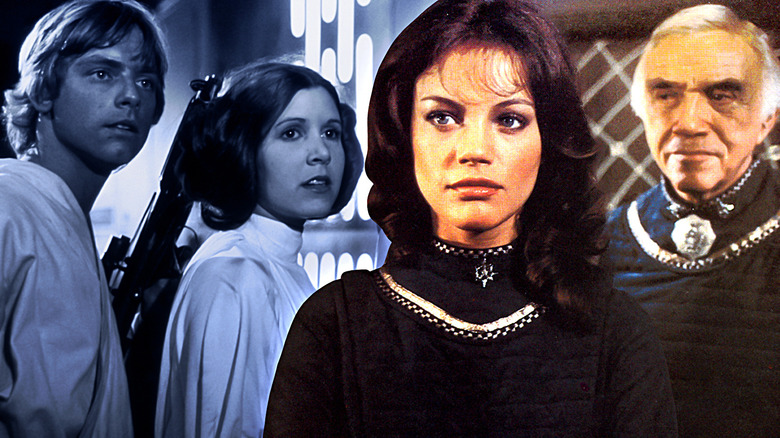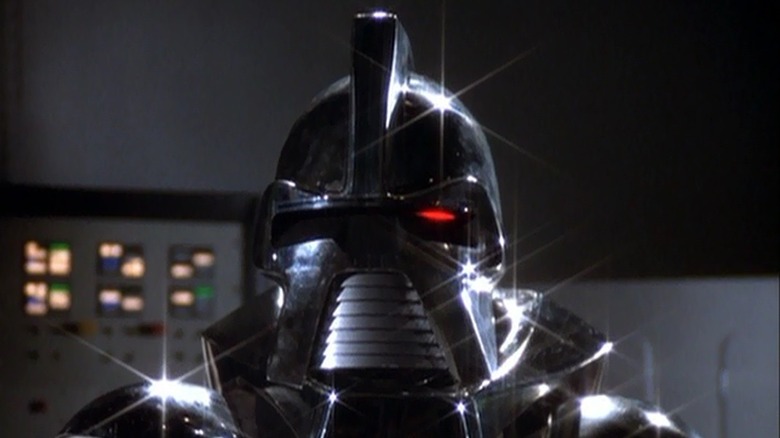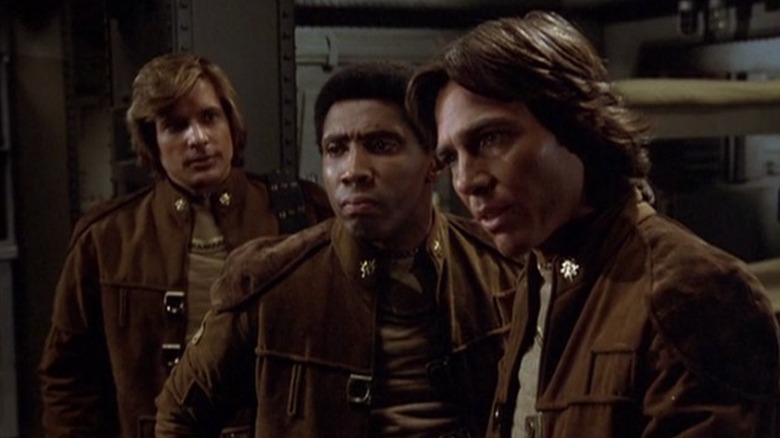46 Years Ago, George Lucas Sued Battlestar Galactica Over Star Wars Similarities
Hollywood has been chasing the blockbuster high of "Star Wars" since 1977 — and often falling short. One of the first and most transparent copies, though, was on television. In 1978, Glen A. Larson created a space opera for serialization on ABC: "Battlestar Galactica." Set in far-away space, the series kicked off with the TV movie "Saga of a Star World." Humans, living on 12 planets named for the astrological signs, are at war with a robot race called the Cylons. A surprise attack sees the Cylons laying waste to their enemies — the remaining humans flee in a "ragtag fugitive fleet" led by the eponymous starship.
The "Star Wars" similarities are obvious, both in narrative and aesthetic. Lieutenant Starbuck (Dirk Benedict) in "Battlestar Galactica" is a cocky starship pilot, clearly modeled on Han Solo (Harrison Ford). Like the X-Wings in "Star Wars," the heroes fly one-man, fighter jet style ships ("Vipers") into battle. A destroyed homeworld echoes the Death Star atomizing Alderaan. On the side of evil, the Cylon Centurions wear helmets resembling Darth Vader's and function like Stormtroopers. The wide frames and clunky hull plating of the Cylons' ships, aka Basestars, evoke the Empire's Star Destroyers.
Both shows also feature humans living on planets besides Earth. While the galaxy far, far away is still unconnected to ours, "Battlestar" makes the absence of Earth a plot point. The survivor fleet is searching for a new home and chasing down myths that a 13th tribe of men settled on a planet called "Earth."
However, this and other superficial differences weren't enough to appease the owners of "Star Wars." In fact, "Battlestar Galactica" wound up the lynchpin of the 1978 lawsuit Twentieth Century-Fox Film Corp v. MCA, Inc.
How the Star Wars/Battlestar Galactica lawsuit was decided
The case was initially filed in the Central District Court of California. Fox and Lucasfilm argued that "Battlestar Galactica" was too similar to "Star Wars" to be anything but a transparent rip-off. MCA, Universal, and ABC naturally contested this and pushed for a summary judgment (where a court decides in favor of one party, without a jury or trial).
District Court Judge Irving Hill granted the summary judgment in October 1980, but the plaintiffs appealed to the Ninth Circuit Court. After arguments in 1982, the circuit court released a decision overruling the summary judgment in January 1983. "After viewing the 'Star Wars' and 'Battlestar' motion pictures, we conclude that the films do in fact raise genuine issues of material fact as to whether only the 'Star Wars' idea or the expression of that idea was copied," the Ninth Circuit judges wrote.
The judges did not, to be clear, declare there was plagiarism from "Star Wars" in "Battlestar," only that the question of there being so was not open-and-shut enough for a summary judgment. "At a minimum, it is a close enough question that it should be resolved by way of a trial. We intimate no opinion whether the films are substantially similar as to either idea or expression, but state only that reasonable minds could differ on those key factual issues." No trial ever happened, though, because Fox and co. and MCA and co. settled the case in November 1983. $225,00 was paid to Fox the following March, according to "The Making of Star Wars: The Empire Strikes Back" by J.W. Rinzler.
What came next for Battlestar Galactica?
A big reason for the similarities between "Star Wars" and "Battlestar Galactica" is because they shared several key designers. "Star Wars" concept artist Ralph McQuarrie also provided concept art for "Galactica." Meanwhile, the visual effects in "Battlestar Galactica" were handled by John Dykstra (who'd worked on "Star Wars") and his company Apogee inc. Dykstra had created Apogee with other alumni from Industrial Light and Magic (ILM), the effects company Lucas founded to make "Star Wars." When you have overlapping crews working on two productions in the same genre, similarities are inevitable.
According to Rinzler's aforementioned book, Dykstra using techniques he'd refined at ILM to help make "Battlestar Galactica" is a key reason why Lucas was peeved at the show's existence. That, and because an (in his view) inferior product like "Battlestar Galactica" would close off interest in a real "Star Wars" TV show. ("They've already spoiled the television market.")
But by the time of the settlement, "Galactica" had already been canceled; it only ran for one season of 24 episodes, and the revival "Galactica 1980" ended after 10 episodes. 40+ years would pass before a live-action "Star Wars" television series ("The Mandalorian"), but Lucas' space franchise, not Larson's, is still easily the victor in the court of public opinion.
It took until 2003 for "Battlestar Galactica" to become a hit, with a darker "reimagining" that ran for four seasons on the Sci-Fi channel. The new series cast off the pulpy space adventure feel of the original, instead taking more after "Star Trek" (co-creator Ronald D. Moore was a long-time "Trek" writer and used "Galactica" to tell stories he couldn't at his old job) and "Blade Runner" (the reimagined Cylons were created by man and strive to exist in their creators' image). With a camp deficit ("BSG '03" played up the post-apocalyptic side of the premise much more than the original), social relevance in post 9/11 America, and excellent acting/characterization among the lead cast, "Battlestar Galactica" finally became a hit 25 years late. Not bad for what began as a cheesy, quickly-canned "Star Wars" knock-off.


